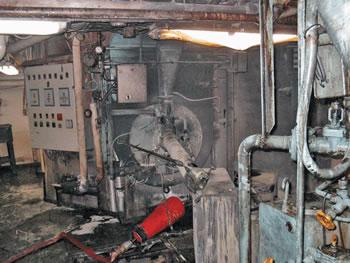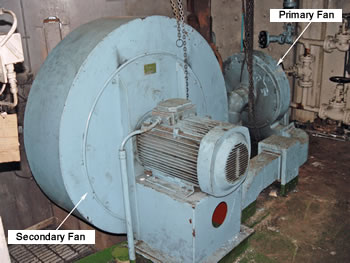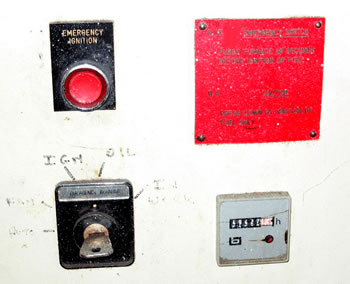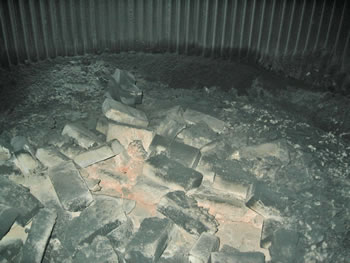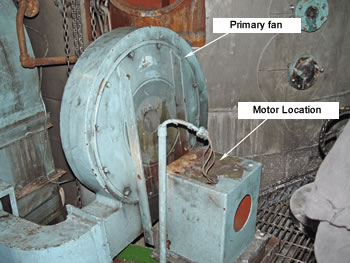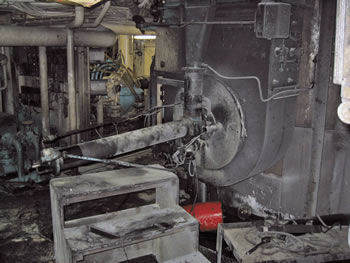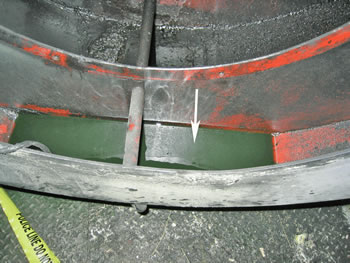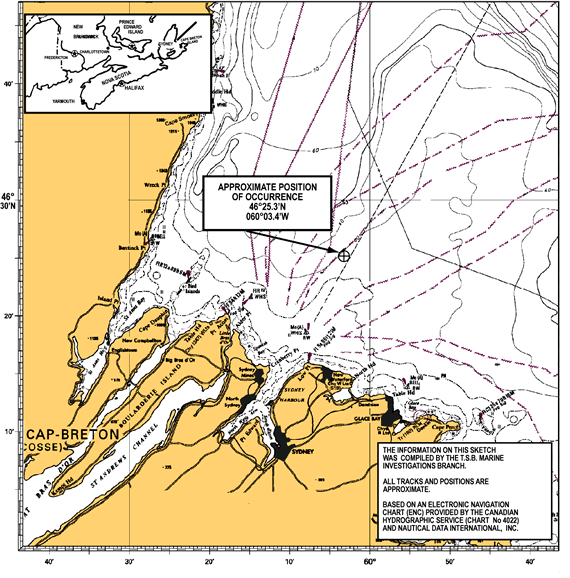Furnace explosion - Starboard auxiliary boiler
Ro-ro passenger ferry Caribou
14 nm North-northeast of North Sydney,
Nova Scotia
The Transportation Safety Board of Canada (TSB) investigated this occurrence for the purpose of advancing transportation safety. It is not the function of the Board to assign fault or determine civil or criminal liability. This report is not created for use in the context of legal, disciplinary or other proceedings. See Ownership and use of content. Masculine pronouns and position titles may be used to signify all genders to comply with the Canadian Transportation Accident Investigation and Safety Board Act (S.C. 1989, c. 3).
Summary
On the morning of 04 March 2004, the ro-ro passenger ferry Caribou departed Port aux Basques, Newfoundland and Labrador, on a regularly scheduled six-hour crossing to North Sydney, Nova Scotia.
At about 1620, approximately 14 nautical miles from the North Sydney terminal, a series of furnace explosions occurred in the starboard auxiliary boiler. The resulting fires were quickly extinguished and the Caribou completed its voyage. One of two officers who suffered burns was airlifted to Halifax, Nova Scotia, for special medical treatment.
Factual information
Particulars of the vessel
| Name | Caribou |
|---|---|
| Official number | 803736 |
| Port of registry | St. John's, Newfoundland and Labrador |
| Flag | Canada |
| Type | Ro-ro, passenger and vehicle ferry |
| Gross tonnage | 27 212 |
| LengthFootnote 1 | 172.8 m |
| Draught | Fwd: 6.7m Aft: 6.4m |
| Built | 1985, M.I.L. Davie, Lauzon, Quebec |
| Propulsion | 4 diesel engines MAK 8M552, 20 600 kW, 2 controllable pitch propellers |
| Cargo | Private motor vehicles, tractor trailers, drop trailers |
| Crew Members | 70 |
| Other | 4 Marine Atlantic Employees, 3 Cadets |
| Passengers | 23 |
| Owner | Marine Atlantic Inc., St. John's, Newfoundland and Labrador |
Description of vessel
The Caribou was built in 1985 as a roll on-roll off (ro-ro) ferry to transport passengers and vehicular traffic between Nova Scotia and Newfoundland. Vehicles are carried on decks 1 and 3, and passenger facilities are on decks 3 through 7. The vessel can accommodate 1313 passengers, and 370 automobiles or 77 tractor trailers, and may have a crew of up to 87 personnel.
History of the voyage
At 1130Footnote 2 on 04 March 2004, the ro-ro passenger ferry Caribou with 23 passengers, 3 cadets, 4 Marine Atlantic employees and 70 crew departed on a scheduled crossing from Port aux Basques, Newfoundland, to North Sydney, Nova Scotia. The first two hours of the voyage were uneventful. Three propulsion engines were on line prior to the occurrence.
At 1340, the machinery alarm and monitoring system (AMS) detected a flame failure (flame-out) in the starboard auxiliary heating boiler. The boiler was reset, and a restart was attempted, but the burner failed to light. The second engineer checked the fuel filters and finding one dirty, replaced it. The pilot burner assembly was then removed and, suspecting the fuel nozzle to be dirty, the existing 2.5 gallon-per-hour (gph) nozzle was also removed and replaced with a spare one rated at 2 gph. The pilot burner assembly was re-installed and a restart attempted. Once again the burner failed to light.
The pilot burner assembly was withdrawn and a series of tests were carried out to confirm the presence of an ignition spark and to assess the quality of the fuel nozzle spray pattern. The spray pattern was good, but the spark appeared weak, which required adjusting the ignition electrodes. With the assembly reinstalled, another restart proved unsuccessful.
The pilot burner assembly was withdrawn. Soon afterwards, the chief engineer, who had originally gone to the machinery control room to pick up the log book, was informed of the boiler problems. He immediately proceeded to the starboard boiler to assist the second engineer. The senior chief electrical officer, who was passing through the engine room, also stopped to assist. The second engineer left to look for a spare replacement fuel nozzle, while the chief engineer and senior chief electrical officer carried out the same checks that had already been performed. During these checks it was discovered that one of the electrodes was grounding out. A spare fuel nozzle could not be located, but a new set of electrodes was installed, adjusted, and a boiler restart attempted. Again the boiler failed to ignite.
After removing the pilot burner, it was found that one of the electrodes had shifted. The electrode was readjusted, and the pilot burner was re-installed, but the unit failed to start. After one more unsuccessful set of checks and adjustments, the decision was made to fire the boiler in the emergency running mode. One, possibly two, failed attempts were made at firing the boiler using this procedure.
At approximately 1620, the chief and second engineers went to the machinery control room away from the noise to discuss the problem, while the senior chief electrical officer went to the port boiler to compare the settings of the two units. When the chief and second engineers arrived at the machinery control room , they heard a loud bang. A cloud of black smoke was seen forming in the starboard forward section of the engine room. The chief engineer went to the boiler, while the second engineer started the fire pump. The wheelhouse was informed of the situation, the engine room fans were shutdown, and the main propulsion engines were then slowed to idle. The resulting fire on the starboard boiler at the time of the first explosion was quickly extinguished using a portable extinguisher.
The chief engineer and senior chief electrical officer were both standing in the general vicinity of the starboard boiler when a second explosion occurred. The chief engineer suffered burns from the explosion, and he retreated to an adjacent compartment. The senior chief electrical officer also received burns while extinguishing the ensuing fire.
Shortly thereafter, a third explosion occurred, and the fire was fought using portable extinguishers and foam. The main power to the starboard boiler was then turned off. Meanwhile, the emergency fire party arrived to counter any flare-ups, and the first-aid team attended to injuries.
At 1630, the fire was declared out. The engine room ventilation fans were restarted, and a fourth main propulsion engine was brought on line.
At 1645, the vessel got underway, arriving at the North Sydney terminal at 1749. The Caribou was met by Emergency Health Services personnel, and the two injured personnel were transferred to hospital for treatment. (See Appendix A - Sketch of the Occurrence Area.)
Injuries to crew
The senior chief electrical officer suffered second-degree burns to his left hand and wrist, while the chief engineer suffered various first-, second- and third-degree burns to his legs, torso, arms, and face.
Damage to the vessel and environment
Damage was confined to the starboard auxiliary boiler. The four securing dogs on the boiler burner assembly door were sheared off. The main and pilot burner tubes, as well as the tertiary air register, were dislodged. The linkage to the main burner air regulator was severed, and the fire bricks lining the floor of the boiler were severely disturbed. Electrical wiring aft of the starboard boiler suffered fire and heat damage.
There was no damage to the ocean environment.
Vessel certification
The Caribou was crewed, certificated, and equipped to existing regulations. The vessel is classed Lloyd's 100A1, and has an ice class, 1A Super. It is subject to regular inspection under Transport Canada (TC) as a Passenger Ship (non-convention) and was last issued a Safety Inspection Certificate (SIC 16) on 04 February 2004, valid until 15 April 2004. The starboard auxiliary boiler is subject to bi-annual inspection and was last surveyed by TC in April 2002. The vessel held valid International Safety Management (ISM)Footnote 3 certification issued by Lloyd's Register of Shipping.
Personnel certification
The master and officers of the Caribou were certificated for the class of vessel and its type of voyage. All of the officers and crew had Marine Emergency Duties training.
Personnel history
The master had 31 years experience with Marine Atlantic Inc. and served approximately 16 years as master on various vessels in the company's fleet. The chief engineer had approximately 22 years sea experience and 9 years as chief engineer. This was his second trip on the Caribou. The second engineer had been employed by Marine Atlantic since June 2002 with four-months experience on the Caribou. The senior chief electrical officer had been employed on the Caribou for 16 years.
Weather
Winds were from the north west at 22 to 33 knots with wave heights estimated at 1 to 2 metres. The air temperature was −3°C.
Passenger/vehicle manifest
The passenger manifest indicated that 13 passengers, 10 truck drivers, 13 tractor-trailers, and 22 drop-trailers (no tractors attached) were on board the vessel.
Auxiliary boilers
Description of the starboard auxiliary boiler
The starboard auxiliary boiler is a SUNROD CPH-120 vertical cylinder, oil-fired steam boiler. It is equipped with a NU-WAY QF3 burner head that is supplied air from both primary and secondary fans. The burner has a control system that regulates the burner either in a fully automatic or in a semi-automatic operation. The duration of the boiler purgeFootnote 4 was set at 30 seconds.
The boiler is also fitted with all mandatory safety devices, which include, but are not limited to, steam pressure cut-in/-out, low water level lock-out, and flame failure lock-out.
Although capable of using heavy fuel, both boilers are fired exclusively using marine diesel oil. The boilers' main fuel supply comes from a ring-main system, and both units also share a common fuel supply for their respective pilot burners that is independent of the main fuel oil supply. The working pressure of the main fuel oil supply is 3 bar, while the working pressure for the pilot burner oil supply is 7 bar.
Combustion air is supplied partly as primary air through the burner itself, and partly as secondary and tertiary air that is introduced through the metal head of the burner. The primary fanFootnote 5 is a high-pressure, low-volume unit, while the secondary fanFootnote 6 is a low-pressure, high-volume unit. Approximately 90 per cent of the combustion air is delivered directly to the burner casing through the two dampers for the secondary and tertiary air. The remaining 10 per cent of the combustion air is passed to the primary .air fan that further raises the pressure of the air so that it will provide sufficient energy to atomize the fuel oil.Footnote 7 The primary fan also supplies combustion air to the pilot burner assembly (see Photo 3).
History of the starboard boiler
On or about 23 February 2004, the primary fan motor on the starboard auxiliary boiler suffered an electrical failure and was sent ashore for repairs. Thereafter, the port auxiliary boiler was in service, with the starboard unit being kept warm on standby. However, at approximately 1130 on 01 March 2004, the burner unit on the port boiler suffered a mechanical problem that necessitated putting the starboard boiler back into service even though it was still missing the primary air fan. The fan from the port boiler was not transferred to the starboard boiler.
History of the port boiler
On 11 August 1997, the port auxiliary boiler suffered a similar furnace explosion that required renewal of the burner unit. The explosion was attributed to fuel oil pooling in the main burner tube and air supply chambers.Footnote 8 There were no reported injuries in that occurrence.
Burner operation
In automatic operation, the burner automatically starts and stops on a signal from the steam pressure switch. A regulating motor is mechanically connected to the fuel modulating valve, air dampers, and inner air cone, and controls the fuel-air ratio (firing rate) according to steam demand. If the boiler flames out while in operation, the burner will lock out to prevent an unauthorized restart.
In semi-automatic operation, the burner automatically starts and stops on a signal from the steam pressure switch, but the boiler only fires at a fixed firing rate, independent of boiler steam demand. The firing rate is adjusted by manually operating the regulating motor and, thereby, increasing or decreasing the fuel and air flow to the burner unit. As with the fully-automatic operation, if the boiler flames out while in operation, the burner will lock out to prevent an unauthorized restart.
Alarm and monitoring system
The main and auxiliary machinery, including both auxiliary heating boilers, are monitored by an alarm and monitoring system (AMS). When a monitored parameter falls outside a predetermined range, the alarm system detects the abnormality and enters an alarm state. Nine boiler points are monitored by the AMS, including flame/ignition failure. Each time a boiler suffers an uncommanded flame failure, the event registers on the AMS. Typically, most AMSs .are fitted with data-logging printers to assist with troubleshooting or with determining the series of events. The AMS onboard the Caribou is capable interfacing with a printer, but none was fitted.
Fuel oil pressures
The boiler fuel pressures recorded after the occurrence were
- Main Burner Fuel Oil Pressure - 2 bar and
- Pilot Burner Fuel Oil Pressure - 2.5 bar.
Emergency operation
In the event that the automatic oil burner control fails, the boiler can be fired in an emergency mode of operation using a keyed switch (see Photo 4). Unlike firing the boiler using the oil burner control, all steps essential to firing the boiler are carried out manually, and all safety devices, including the flame monitoring device, are bypassed.
When the chief and second engineers left the starboard auxiliary boiler, the main power switch was left in the ON position, the emergency running switch was in the automatic position, and the hand-auto switch was either in the automatic or in the manual position.
Furnace explosions
General
Minor furnace explosions are often referred to as flashbacks or blowbacks. The basic cause of a furnace explosion is the ignition of an accumulated combustible mixture within the confined space of the furnace/combustion chamber. The flammable mixture within this enclosure consists of an accumulated quantity of combustibles that, when mixed with air in the correct proportions between the upper and lower explosive limits,Footnote 9 will result in rapid and uncontrolled combustion when an ignition source is applied. The size and intensity of the explosion depend largely on the quantity of combustibles and the fuel-to-air ratio at the time of ignition.
Secondary explosions
When a primary explosion occurs within a contained space, the resulting damage may allow air to be drawn into the partial vacuum created by the rapid combustion/explosion. The primary explosion can result in a secondary explosion by disrupting,Footnote 10 dispersing, and igniting new sources of fuel. Secondary explosions can be considerably more destructive than the primary explosion, and every primary explosion may cause several secondary explosions.
The force of the explosions was greater than the boiler burner assembly door could withstand; the four securing dogs were sheared off, and the burner door was partially opened. The force of the blast also dislodged the main and pilot burner tubes, and the tertiary air register, and severed the linkage to the main burner air regulator. It was also of sufficient magnitude to disturb the fire bricks lining the floor of the boiler (see Photo 5).
Uniform and protective clothing
The chief engineer was wearing a polyester-cotton short-sleeve dress shirt and polyester-wool pants. This was his normal on duty, supervisory attire. The senior chief electrical officer wore a dress uniform similar to that worn by the chief engineer, but supplemented by a polyester-wool battle dress jacket and a polyester safety vest. The second engineer was wearing coveralls.Footnote 11
The clothing worn by all three individuals was provided by Marine Atlantic. None of these items were treated to enhance flame-retardant properties. The uniform shirt and pants worn by the chief engineer were extensively burned or melted by contact with the flame front from the second explosion. The back of the pants, safety vest, and battle jacket worn by the senior chief electrical officer caught fire and burned through as a result of the third explosion.
Marine Atlantic uniform issue
The uniform and protective clothing issued to Marine Atlantic employees is manufactured from a variety of fabrics, whose fibre content ranges from 100 per cent natural fibres to 100 per cent synthetic fibres and includes numerous fibre blends. None of the clothing issued by the company, other than the rain gear, was treated to enhance flame-retardant properties (see Appendix B - Marine Atlantic Uniform Issue).
Flammability characteristics of various fabrics
Fabrics are manufactured from natural or manufactured fibres, or a combination of the two. Natural fibres are produced from either plants (cellulose) or animals (protein). Manufactured fibres are produced by combining simple compounds (monomers) to form more complex compounds or polymers. Each fibre, whether natural or manufactured, has its own unique durability and flammability characteristics. Fabrics made from cellulose fibres tend to be more durable, but exhibit poor flammability characteristics. Fabrics produced from protein fibres, on the other hand, are less durable, but demonstrate good flammability properties. Manufactured synthetic fabrics, although durable, are generally heat sensitive. Modern textiles are often produced by combining natural and manufactured fibres to obtain the flammability properties of one and the durability characteristics of the other.Footnote 12
| NAME OF FABRIC | TYPE | IGNITION TEMPERATURE | FLAMMABILITY CHARACTERISTICS | ||
|---|---|---|---|---|---|
| Reaction to heat source | Condition after removal of heat source | To improve fire-retardant properties | |||
| Cotton | Natural, cellulose | 400°C | Burns readily and supports combustion | Often produces afterglow | Increase weight and weave or add fire-retardant chemicals |
| Wool | Natural, protein | 590°C | Flame propagation is gradual | Extinguishes with no afterglow | Least flammable of all natural fibres |
| Polyester | Synthetic polymers | 10°C | Burns readily, melts and draws away from heat source | Affected areas cool to form a stiff material | Difficult to modify flammability characteristics |
| Polyester cotton blend | Synthetic plus natural | Above 400°C, but below 510°C | Shrinks, melts before ignition, then flame propagates quickly | Cools to form a crispy, paper-like, substance | Only the cotton is treatable with fire-retardant chemicals |
Laundering practices and flame resistance
Improper laundering can degrade the flammability characteristics of fabrics with natural flame-resistant properties, as well as those treated with flame-resistant chemicals. Failing to follow the manufacturer's washing instructions, or even using liquid fabric softener, can seriously alter a fabric's flame-resistant properties.
Regulatory requirements
The marine requirements for uniform/protective clothing are referenced in the Marine Occupational Safety and Health RegulationsFootnote 13 and the Safe Working Practices Regulations.Footnote 14 The regulations, however, offer no guidance as to what fabrics may constitute suitable uniform/protective clothing. Although not applicable to the marine industry, parallels can be drawn from a Transport Canada System Safety Air Carrier Advisory Circular, which informed air operators of the potential hazards when uniforms issued to flight attendants do not provide adequate protection in situations involving fire or emergency evacuations.Footnote 15
Analysis
Instruction manual
In 1996, Marine Atlantic was the first Canadian ferry operation to become International Safety Management (ISM) certified. In applying the ISM Code, shipping companies such as Marine Atlantic mitigate human performance-based decisions that may lead to an accident. The provision of adequate policies and procedures enables the ship's crew to be better equipped to make correct decisions of a day-to-day operational nature. To implement the ISM Code, Marine Atlantic established, among other things, instructions and procedures to further safety and for environmental protection.
In the case of machinery operations, such procedures must encompass the machinery manufacturer's instructions, and such instructions must be readily available to ensure that machinery is operated safely and efficiently.
Although there was a boiler instruction manual on board, key engineering personnel were unaware of its location. Consequently, adjustments to the ignition electrodes were made by best estimate rather than being set precisely in accordance with the manual. It was also determined, after obtaining the instruction manual (which was found to be incomplete and somewhat disorganized), that the pilot burner fuel pressure had been set much lower than that specified. A second boiler instruction manual discovered onboard several days later was also found to be incomplete and disorganized.
Primary fan
At the time of the occurrence, the electric motor for the primary fan was still ashore for repairs, and the starboard auxiliary boiler was being operated without it (see Photo 6). This resulted in less than adequate atomization of the fuel from the main burner and an unstable main flame. It would also cause large droplets of unburned fuel oil to carry over and accumulate in the secondary and tertiary register air boxes, as well as in the combustion chamber.
Although the primary fan motor on the mechanically-defective port boiler was available, it was originally hoped that repairs to the port boiler would have been completed sooner than they ultimately were. Consideration, therefore, was not given to having it replace the missing motor on the starboard unit. The functioning of the primary fan is essential to safely operate the boiler.
Fuel pressure setting of burner
The main fuel oil pressure observed at 2 bar, fell within the acceptable range of 1 to 3 bar for light fuel operation as indicated in the boiler instruction manual.Footnote 16 The pilot burner fuel oil pressure at 2.5 bar, however, fell well below the designed working pressure of 7 bar. At this lower pressure, the atomization of the pilot burner fuel would have been very poor and would have caused unburned droplets of fuel to collect in the combustion chamber.
The pilot burner nozzle in use at the initial boiler flame out was a 2.5 gph unit. This nozzle was removed and replaced with a 2.0 gph unit. According to the SUNROD instruction manual, the recommended pilot burner nozzle should range between 4.5 gph and 5.5 gph. The boiler manufacturer however, indicated that a 2.0 gph nozzle would be acceptable if the fuel oil pressure was set at 7 bar.
At the time of the occurrence, the boiler was not being operated in accordance with the manufacturer's instructions and specifications. The smaller-than-specified burner nozzle and low fuel pressure, combined with the lack of combustion air from the primary fan, made the pilot burner flame difficult to ignite, which resulted in the multiple flame failures of the main burner prior to the explosion.
Emergency running switch
The emergency running switch, as its name implies, is to be used only in an emergency or when carrying out tests on the boiler. Since its use must be carefully controlled, it is fitted with a key. Despite the danger associated with unauthorized use of the emergency running switch, the key was left in the switch. After the occurrence, considerable resistance was felt as the key was removed from the switch. This, coupled with signs of corrosion, indicates that the key had not been recently removed from the switch.
Furnace explosion
Throughout the afternoon, unsuccessful attempts were made to restart the boiler in both the automatic and emergency modes. Because the vessel's AMS was not fitted with a data-logging printer, the exact number of attempts could not be determined. At least four attempts were made to restart the boiler with the system on automatic, and one, possibly two, attempts were made to restart the boiler while firing on emergency. During an emergency firing, the duration of fuel injection is manually controlled by the operator. The boiler instruction manual warns against introducing fuel for more than five seconds without repurging the boiler for at least 30 seconds. Whether this warning was heeded could not be determined; however, it is known that the manufacturer's manual was not readily available for reference by the engineers. With each failed attempt, unburned fuel would have been sprayed into the combustion chamber and air boxes, and onto the firebricks which lined the furnace floor. Until the time of the occurrence, the boiler had operated throughout the day and would have been at a temperature well above the flash point of the unburned fuel. Some of the fuel would have vaporized in the furnace, with the remaining residue likely seeping down between the joints in the fire bricks.
When the chief and second engineers left the starboard auxiliary boiler, the main power switch was left in the ON position, the emergency running switch was in the automatic position, and the hand-auto switch was either in the automatic or in the manual position. Therefore, it is likely that soon after the emergency running switch was switched to automatic, the oil burner control commenced a normal start-up cycle. The first furnace explosion was the result of the ignition and instantaneous combustion of a flammable air-fuel mixture that had carried over from the secondary and tertiary register air boxes and had accumulated in the combustion chamber and uptake. The likely source of ignition was the pilot burner ignitor. The second and third explosions were most likely secondary (tertiary) explosions.
The cause of the fires that followed each of the three furnace explosions were likely the result of the ignition of the fuel oil that had pooled in the secondary and tertiary register air boxes and its subsequent discharge out of the boiler during each explosion (see Photo 8).
Since the starboard auxiliary boiler was in a less than ideal operational condition with the primary fan unit being out of commission, using it required that all possible safety measures be taken beforehand.
Injuries to crew
Of the three individuals who were working on the starboard auxiliary boiler during the afternoon of the occurrence, the second engineer was not near the boiler when either of the explosions occurred and, therefore, did not sustain any injuries.
The chief engineer was standing near the boiler. He sustained burns to his legs, torso, arms, and face during the second explosion that were consistent with the effects of a flame front. As such, had his clothing had flame-retardant properties, the severity of the injuries to his torso and legs would have been mitigated. The shirt worn by the chief engineer had short sleeves; shirts that qualify as flame retardant must have long sleeves to provide a measure of protection to the arms.
The senior chief electrical officer was not directly affected by the flame fronts from the first and second explosions. As the result of the flame front from the third explosion, his pants, safety-vest, and battle jacket caught fire; however, these flames were extinguished before he sustained any serious injury. The burns to his left hand and wrist occurred while fighting the fires following the explosions. While his injuries were not affected by the characteristics of the clothing he was wearing, the lack of fire-retardant properties in his pants, safety-vest, and battle jacket exposed him to an increased risk of serious injury.
Provision of protective clothing
The protective clothing available on the market includes items manufactured with fabric blends of 88 per cent cotton and 12 per cent high-tenacity nylon that is treated to not support combustion once the ignition source is removed. However, the coveralls supplied by the owners as protective clothing for use in the engine room environment were either 65 per cent polyester, 35 per cent cotton, or 100 per cent cotton and were not fire resistant. Given the risk exposure of shipboard personnel to fire incidents, the protective gear supplied or available to the crew was not consistent with their risk exposure profile.
Findings
Findings as to causes and contributing factors
- The starboard auxiliary boiler was not being operated in accordance with the manufacturer's instructions and specifications.
- The boiler manufacturer's instruction manuals were not readily available, were not referenced by the crew, and were disorganized and incomplete.
- The starboard auxiliary boiler was being operated without a primary air fan, and was left unattended with the power switch ON and the unit on automatic.
- The furnace explosions were the result of a series of uncontrolled ignitions of an accumulated combustible fuel/air mixture within the enclosed space of the furnace combustion chamber and uptake.
- The fires were likely the result of the ignition of the fuel oil that had pooled in the secondary and tertiary register air boxes and its subsequent discharge out of the boiler during each explosion.
Findings as to risk
- The key to the emergency burner control switch was stored in the switch.
- Clothing worn by the chief engineer and senior chief electrical officer had no flame-retardant properties and offered no protection against the flame fronts of the explosions. This contributed to the severity of the chief engineer's injuries and exposed the senior chief electrical officer to the risk of sustaining more extensive and serious injuries.
- The protective clothing supplied to the crew by the owners was inconsistent with the crew's risk profile.
Safety action
Action taken
The following safety action was initiated by Marine Atlantic Incorporated.
- A complete boiler instruction manual that was held ashore was reproduced, and two copies were placed on board the vessel.
- The in-service and stand-by pilot burner fuel oil pump pressures were adjusted to specification.
- The in-service and stand-by main burner fuel oil pump pressure were adjusted to specification.
- Two additional auxiliary boiler emergency shutdowns were installed in strategic locations throughout the engine room spaces.
- The starboard auxiliary boiler was fitted with a new burner unit under the supervision of a factory service engineer.
- The port auxiliary boiler was adjusted to the manufacturer's specification by a factory service engineer.
- It is the company's intention to segregate and provide independent fuel systems for each boiler in May 2005.
- The Personal Protective Equipment Program has been enhanced to ensure that a proper assessment of any task is carried out, and that correct personal protective equipment is obtained to provide the necessary protection for employees.
- A Job Safety Analysis Program has been developed. Under this program, tasks will be assessed to identify associated risks before work is undertaken.
- The dynamics of the safety management system documentation has been used to ensure that all employees working in the engine room now wear Marine Atlantic-provided fire-retardant coveralls.
Action required
Simply stated, the purpose of the Marine Occupational Safety and Health Regulations (MOSH) made pursuant to the Canada Labour Code Part II (the Code) is to protect employees against health and safety hazards on the job. Preventive measures should first require the elimination of hazards or, if this is not possible, the reduction of such hazards and, finally, the provision of personal protective equipment, clothing, devices, or materials, all with the goal of ensuring the health and safety of employees.Footnote 17 While the goal of internal company safety management systems is, in part, to identify and manage the hazards on board vessels, not all hazards can be totally eliminated.
Vessels have numerous sources of flash fires: boilers, engine crankcases, medium-voltage electrical equipment, galleys, and cargo operations to name a few. Since flash fires can occur without warning, identifying hazards and using appropriate personal protective equipment is quite important.
The MOSH regulations includes provisions for head, foot, eye, face, skin, respiratory, and fall protection. Specific Canada Shipping Act standards are set for headgear, footwear, face, eye, and fall protection; however, no such references are made to protective clothing. The requirement for skin protection cites protection in the form of an "appropriate body covering." Such a general reference may not provide vessel operators or crew with adequate guidance for choosing protective clothing sufficient to protect against identified risks such as flash fires.
The Code and associated MOSH regulations are predicated on the requirement that a vessel operator assesses all inherent risks, including the risk of flash fires, and provides protective clothing as necessary. The Board notes however that few Canadian shipping companies require the use of flame-retardant clothing in high risk areas. As a result, and as evidenced by this occurrence, crew members on Canadian vessels may be placed at unnecessary risk.
Therefore, the Board is concerned that the MOSH regulations pursuant to the Canada Labour Code Part II, or other publications distributed by Transport Canada, do not provide adequate guidance for either assessing the risks of flash fires, or for choosing suitable flame-retardant protective clothing. The Board will be monitoring the situation with a view to assessing the need for further safety action on this issue.
This report concludes the Transportation Safety Board's investigation into this occurrence. Consequently, the Board authorized the release of this report on .
Appendix B - Marine Atlantic uniform issue
| Coveralls | 65% Polyester 35% Cotton | |
|---|---|---|
| Coveralls | 100% Cotton | |
| Rain Gear | Fire Retardant, Oil Resistant | |
| Helmet Liner | 100% Nylon | |
| Helmet Liner | 100% Cotton | |
| Toque | 100% Acrylic | |
| Safety Vests | 100% Polyester | |
| Parka, Orange | 80% Polyester 20% Cotton | |
| Parka, Blue | 60% Polyester 40% Cotton | |
| Jacket, Bomber | Shield 100% Nylon Lining 100% Nylon Knitting 100% Polyester |
|
| Shirt, Work | 65% Polyester 35% Cotton | |
| Pants, Work | 65% Polyester 35% Cotton | |
| Pants, Cook | 65% Polyester 35% Cotton | |
| Shirt, Striped | 65% Polyester 35% Cotton | |
| Shirt, Polo | 50% Polyester 50% Cotton | |
| Skirt, Ladies | 55% Polyester 35% Cotton | |
| Skirt, Ladies | 100% Polyester | |
| Pants, Ladies | 100% Polyester | |
| Cardigan | 100% Pil-Trol ®(low-pill acrylic fibre) | |
| Shirt, Officer | 65% Polyester 35% Cotton | |
| Pants, Officer | 75% Polyester 25% Wool | |
| Jacket, Officer | 75% Polyester 25% Wool | |
| Jacket, Battle Dress | 75% Polyester 25% Wool | |
| Sweater | 100% Wool |

